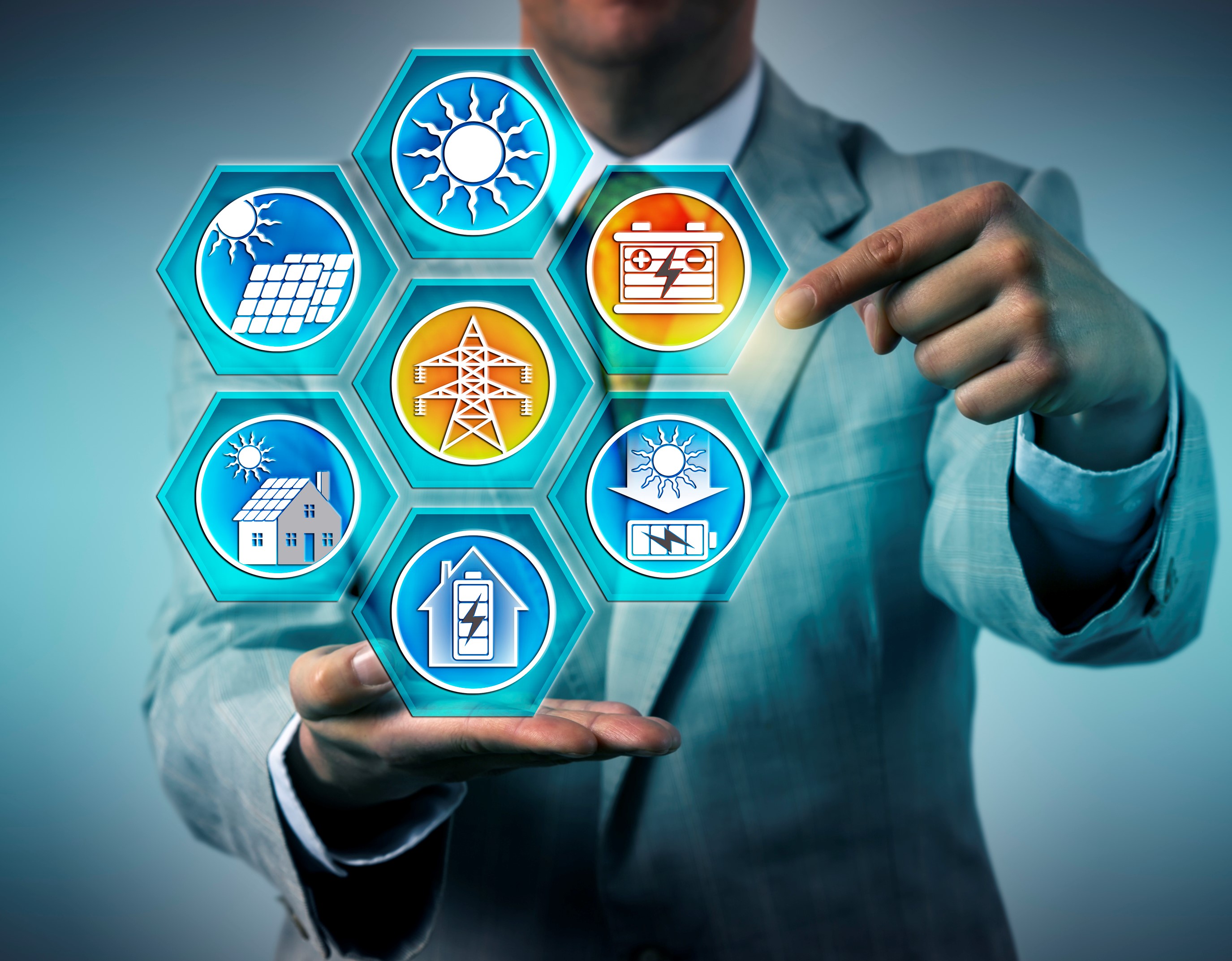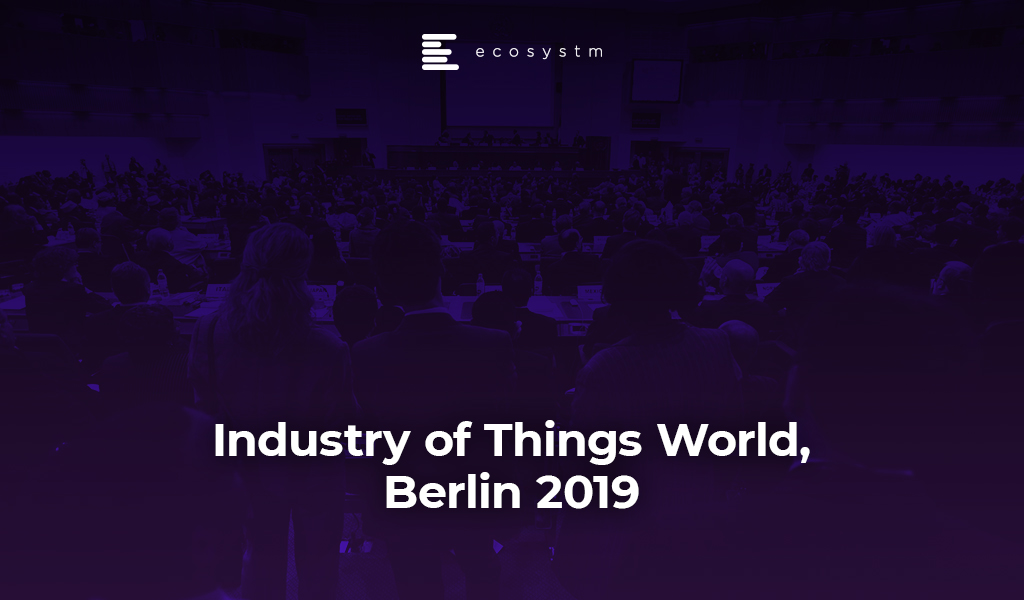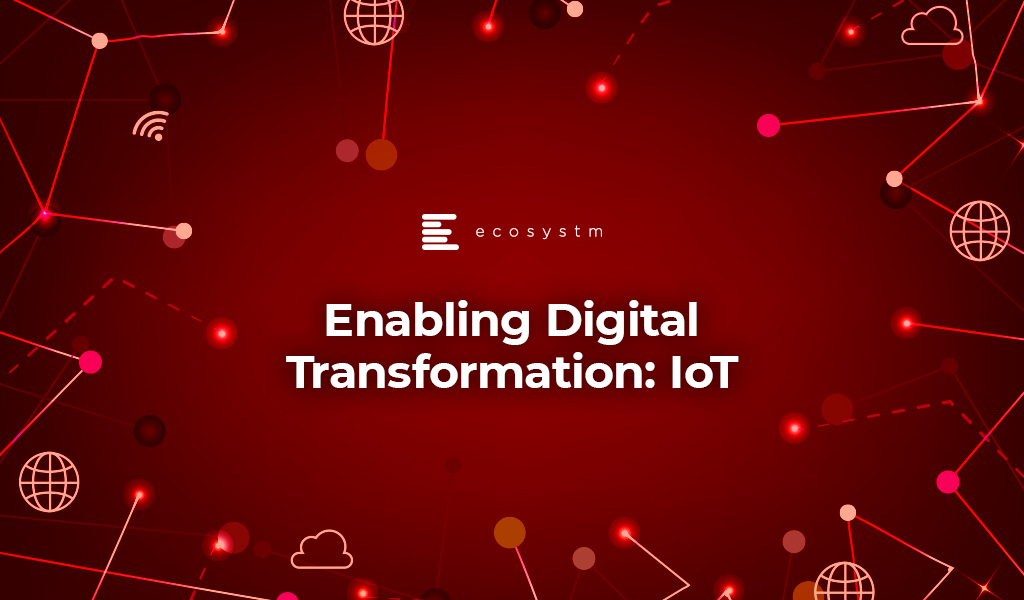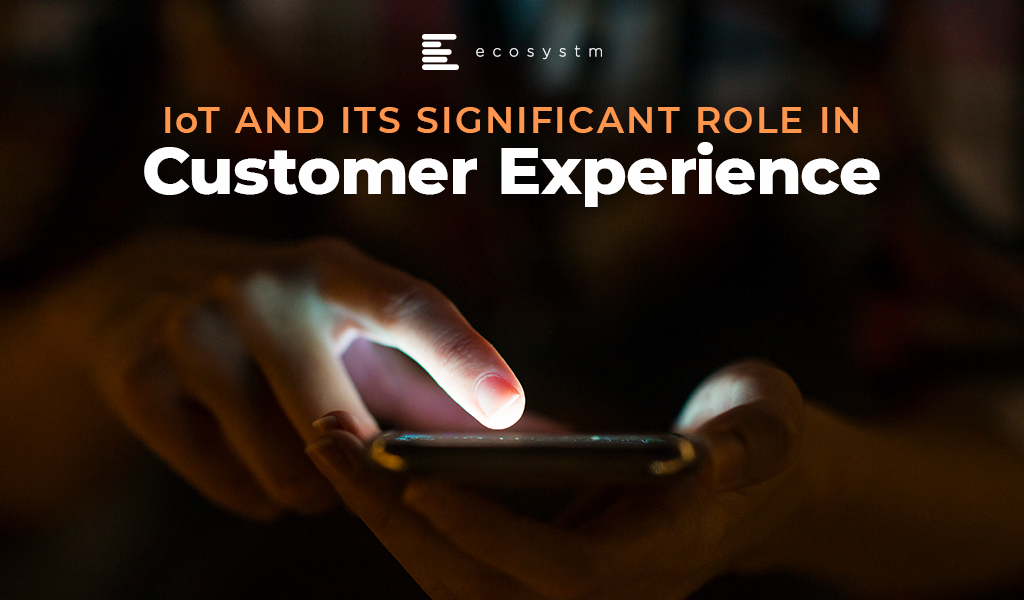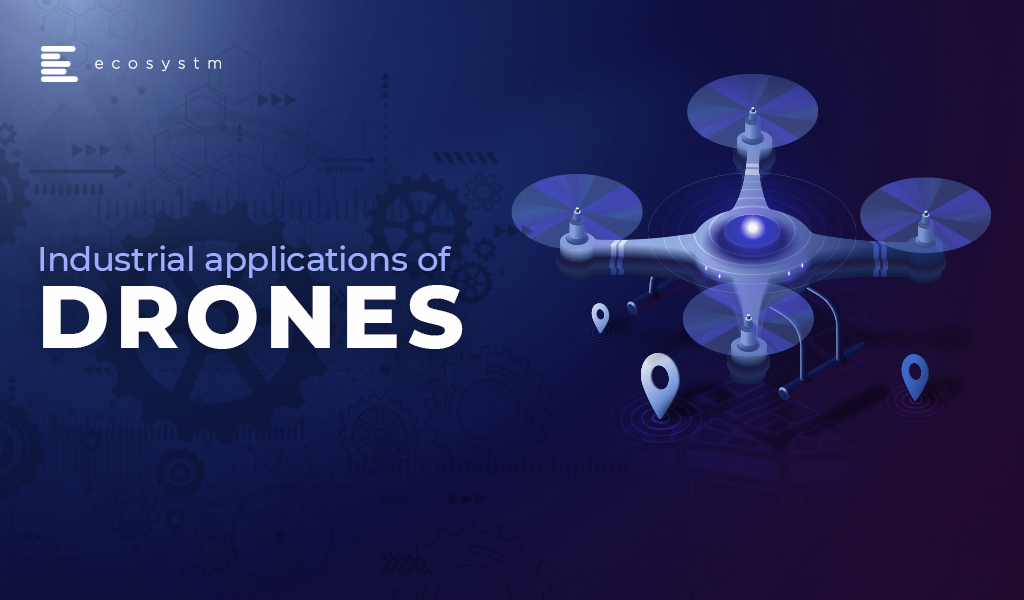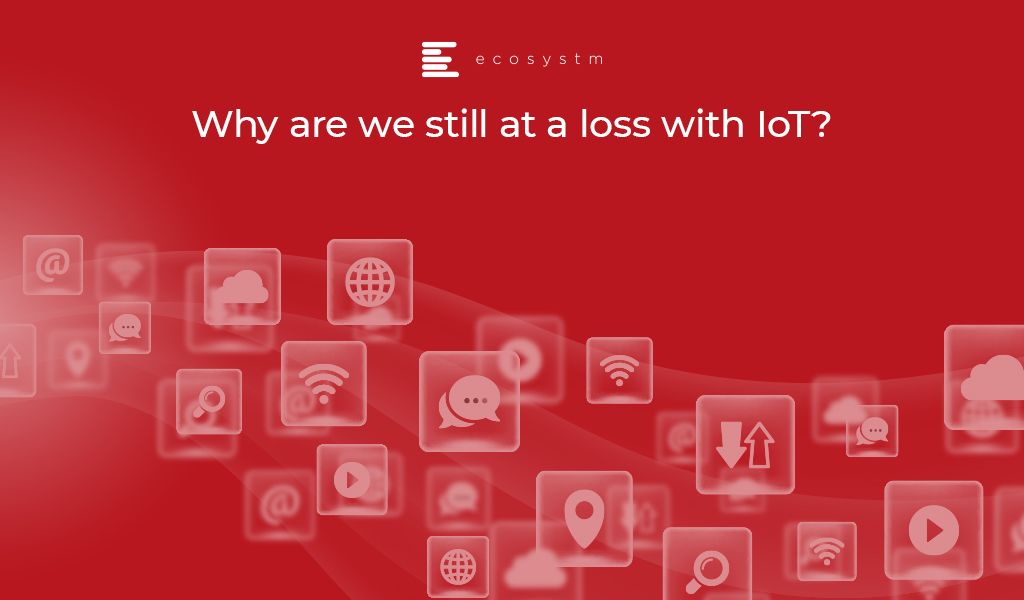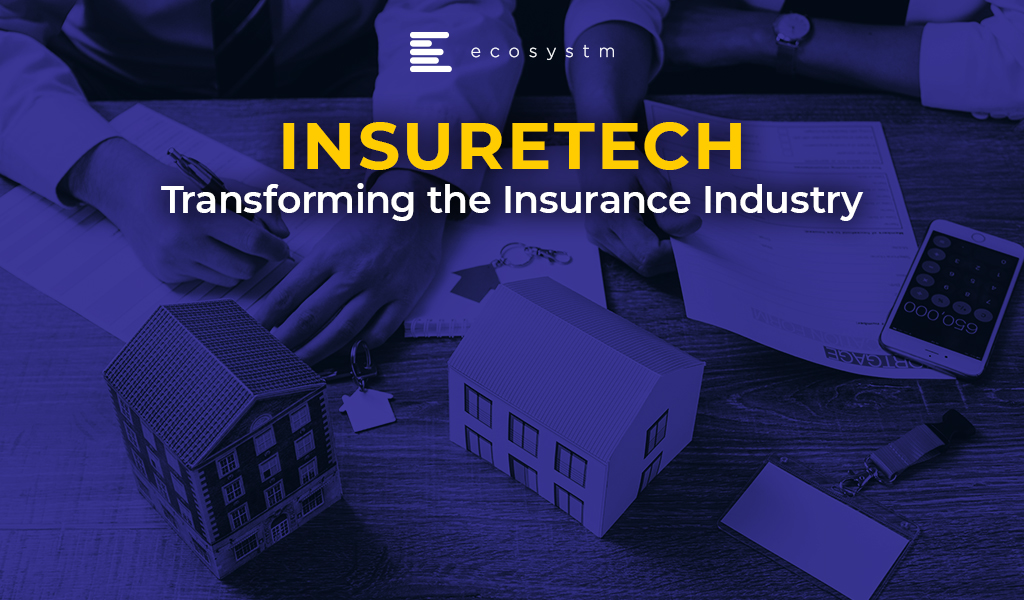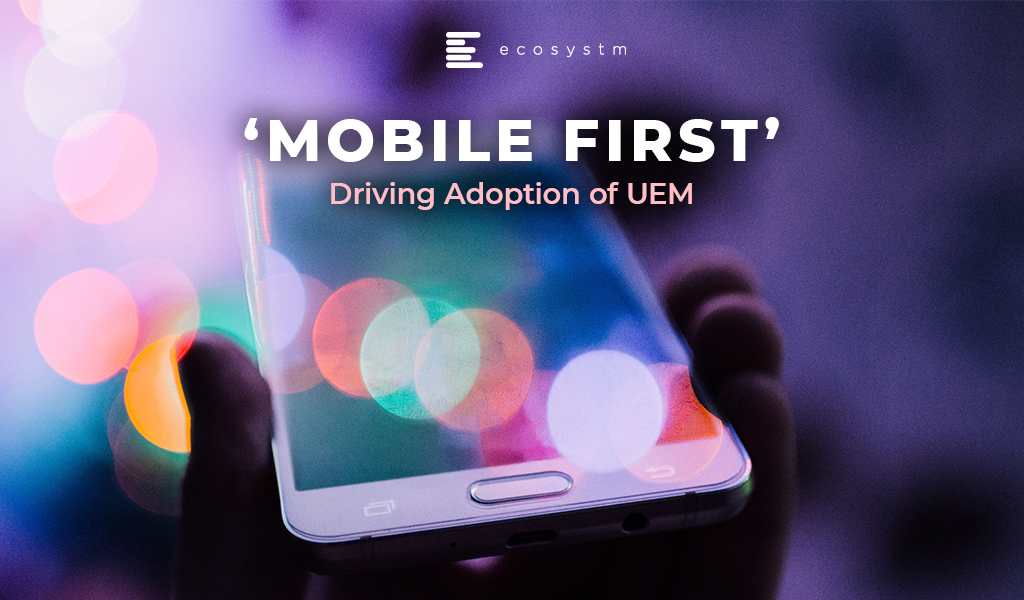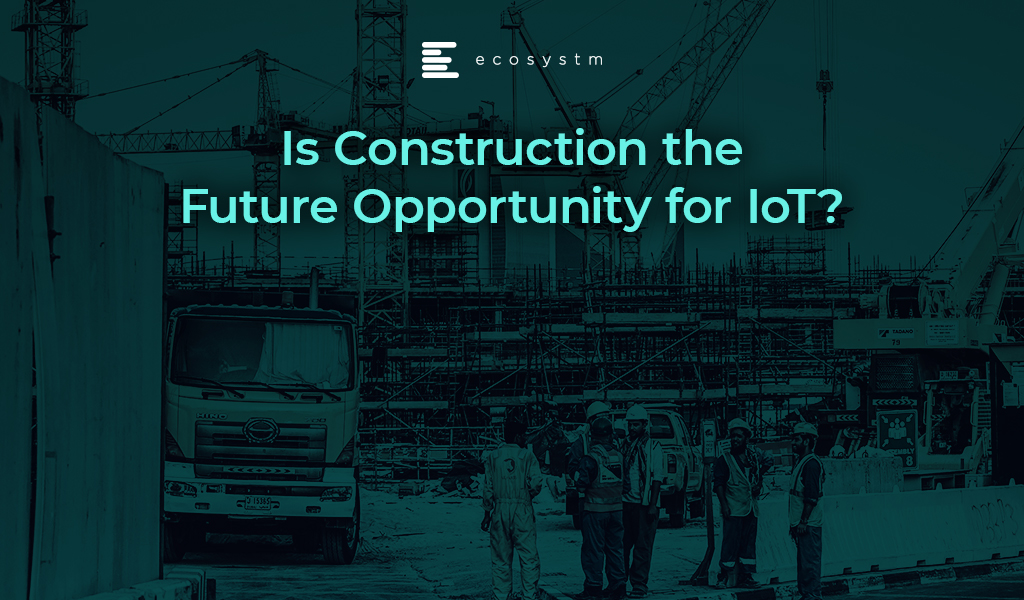One of the most important industry verticals that the Internet Of Things (IoT) is quickly enabling is buildings. To date most of the analyst coverage has been focused on smart building and building management systems collecting sensor data on lighting, temperature monitoring, and occupancy. While IoT device, connectivity, platform, management and integration vendors have marketed their hardware and software differences, the unsung heroes of ‘Smart Buildings’ should be the Facilities Management (FM) assets that have the most influence in the true IoT ecosystem. FM covers a lot of segments in commercial buildings – retail, restaurants, grocery/supermarkets, spas and gymnasiums, retail healthcare and many more and as such these segments create large quantities of business related data from sensors within them. Today’s FM has successfully moved from simply managing ‘boxes’ to managing smart connected facilities.
This week I attended ServiceChannel’s ServiceX19 customer event in Scottsdale, Arizona where 300 ServiceChannel customers were treated to an update on the current and future state of FM. Annually, ServiceChannel’s customers raise over 100 million work orders, across 330,000 locations, fulfilled by 50,000 contractors in 75 countries. Equally impressive is that these customers are responsible for over $37 Billion spend on keeping building clean, bathrooms working, air conditioners heating and chilling, refrigerators cooling, lights switch on and so on.
Through their Facility Management Platform, which behaves like an online market place for their customers, ServiceChannel is rapidly becoming a valuable analytics and data management software company. Work orders are an incredible source of information for every asset connected into a building that requires any level of service. Just like State Farm Insurance who ‘know a thing or two, because we’ve seen a thing or two’, ServiceChannel have seen ‘a thing or two’ such as work orders to deal with alligators and of course cars crashed into shop fronts! However, some examples of more traditional analytics use cases include the following:
- Predictive repairs on capital intensive equipment is being decided by the facilities manager before the original equipment manufacturer.
- By using ServiceChannel’s comprehensive data visualisation capability, facilities managers have the ability to identify measure the difference between spending on preventative maintenance versus post failure repair.
- Individual service fulfillment analysis can often show that engaging with the least expensive hourly rated contractor may not always provide the best outcomes.
Over time ServiceChannel’s data collection and analytics is enabling their customers to have visibility into their businesses that go beyond FM. ServiceChannel is enabling their customers to become more digital and creating higher value business outcomes. While IT and equipment manufacturers have tried to create digital ecosystems and attract participants into their network, they are still one step removed from the customer. This gap means that they are not truly able to help manage the customer experience within smart buildings. Rather, companies like Service Channel have access to the heterogeneous asset environments by working directly with facility managers. During the conference, I saw service records comparing the major HVAC vendors within a large retailer and immediately thought that individual HVAC vendors would be very interested to see how they stacked up against each other. The ServiceChannel connected asset analysis gives their customers the information that enables discussions based on transparency, trust and truth – which is a powerful negotiating tool.
Conclusion
The event showed a reality state of the IoT associated with analytics in an industry that is reinventing itself through enabled assets connected to their work flow systems. It clearly showed that the Smart Buildings industry is probably about 2 years behind the roadmap set out by the major IT research firms. Businesses are now beginning to understand what IoT is even if they do not call it by that name. Connected assets are becoming more familiar and the value from analytics is being realised to run businesses. Customer experience is now a tangible metric!
Separately, as ServiceChannel’s analytics engine matures and external data sources such a weather and environmental conditions are curated with asset management, then facility managers become more valuable to the CFO, the CIO and the customers they serve. To date equipment vendors’ attempts to build ecosystems of IoT-based partners has been met with limited success because they are still not close enough to the end customer. Original equipment vendors should make their products connected to an IoT infrastructure network as easily and as quickly as possible and then partner with companies like ServiceChannel who can curate and promote their asset data.
I had the pleasure of attending the Industry of Things World 2019 in Berlin. Berlin has always fascinated me by its contradictory image – of modernity and traditionality. Their admired industrial companies can be conservative in terms of innovation and move slowly when adopting new technologies. However, once they decide to move, they move all at once and cause a significant change in the industry. And that is what I perceived at the event.
In Berlin, companies know what Industrial IoT (IIoT) is and IIoT solution providers’ efforts focus on how to implement IIoT. The level of adoption in the DACH and Nordic regions is higher than in other European regions but still remains low, especially in small and medium enterprises (SMEs).
The first thing that was highlighted at the event is that AI has not devoured IoT. Organisers do not try to fill auditoriums and beat attendee figure records with other parallel events of AI, Blockchain, AR/VR, 5G, DevOps and so on.
It was interesting to listen to both tech buyers and vendors sharing their news and vision – clients such as Rolls Royce and thyssenkrupp sharing their implementation experiences and giving recommendations on how to succeed in IIoT projects and; IIoT vendors such as Cumulocity IoT, HPE, AWS, Siemens or Huawei presenting their capabilities. All of them are clear that IIoT must be part of a new paradigm of business systems integration.
Key Takeaways:
- In the several round tables that I attended, the ideas and conclusions presented were very educative. It was good to listen to the main actors (the actual companies implementing IIoT) talking about their challenges, requirements, solutions and desires. Most of the CEOs are in consensus on their priorities in IIoT investments: ROI, Performance and Quality.
- I validated with organisations the results of the Ecosystm IoT study regarding their vendor selection criteria for IoT projects. This ties back to their IIoT investment priorities. They are likelier to choose vendors that can deliver on all 3 of their priorities.
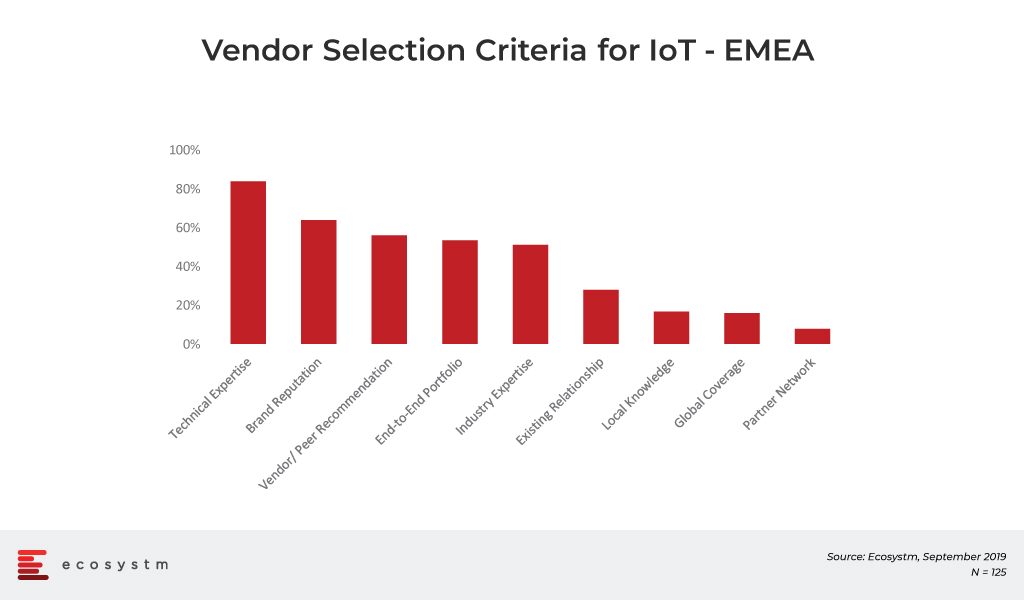
- The most realistic statement about IIoT came from the HPE speaker, “Don’t look for disruptive companies like Uber in the Industrial Internet of Things market.” Here the new business models will take time to emerge. Other exhibitors and visitors, that I had conversations with, agreed with this idea.
- Fortunately for the IIoT market in Germany and Europe at large, China continues to adopt these technologies at a similarly slow pace. Although China may be more advanced in digitalisation (in ePayments for example), when it comes to IIoT, they are as conservative as Europe. This gives us a window of opportunity to continue to evolve our offerings, in the region.
- Another recurrent theme through the event was the inability and hesitance of the CEOs/ CFOs/ Boards to understand the potential of data-based collaboration between companies and industries and how they continue to kill any data sharing/open data initiatives. Walled gardens should not be a medium-term objective.
- The presence of start-ups and enthusiastic entrepreneurs was very heartening – and while I could not speak with all of them, CloudRail, Juconn, TechMass , Ekkono and WolkAbout stood out in my opinion. And of course there were some IIoT Platform vendors such as AWS, Cumulocity IoT, Device Insight, Relayr and Waylay. As I have said many times it is not necessary to analyse 400 platforms – for each local, regional or global enterprise there is a maximum 3-4 platform superheroes vendors to select.
- I had some conversation on IoT connectivity with LumenRadio, SigFox and Multefire However the session discussing the impact and need for 5G in IoT was shallow because the speakers only covered high level use cases and benefits of 5G and how the German government is working on security requirements for end-to-end 5G services.
- Finally, it was great to hear people talking about IoT lifecycle management. It has become clear that IoT is real and is here to stay. Some companies have already passed the Proof of Concept stage. This reassures us that IoT is not just ideas, development and pilots. IoT projects are going beyond and thinking about operations and maintenance.
Congratulations to all nominees in the first Industry of Things World Award ceremony. The winners were Fette Compacting in the category, Best Implementation of IIoT Technology on the shop floor and BAM GmbH up2parts in the category, Best IIoT Product or Service.
One final observation on the event is the disparity in the number of men and women attending. I got the impression that not many women are involved in IIoT or at least they do not attend events such as this. I hope that skills training and the market potential will attract more women to this industry in the future.
So dear friends, contacts, followers and readers: in short, the event was a positive experience and I hope to see some medium-term outcomes in
The internet was created by the US military to create a seamless self-repairing almost indestructible connection of computers and to maintain critical communications capability in the event of nuclear attacks on cities and government infrastructure. It wasn’t until the invention of the world wide web (www) that the internet became widespread. Since then, the evolution of digital and network technologies has made it possible to connect almost any device to the Internet. The Internet of Things (IoT) can include a wide range of machines, sensors, smart objects, unique identifiers (UIDs) – provided they are connected to the Internet and have the ability to send and receive data without human intervention.
There are a plethora of ‘things’ today that can be connected to the internet and are not restricted to devices and sensors alone. Anything with an IP (Internet Protocol) address can now be connected. Wireless technologies such as Wi-Fi, Bluetooth, and 4G/5G have created more possibilities for devices to be individually connected. With the advent of IoT, remote connectivity has become the norm bringing several advantages across all industries. The global Ecosystm IoT study reveals that organisations are looking to leverage IoT not only for asset management but also to fuel innovation.
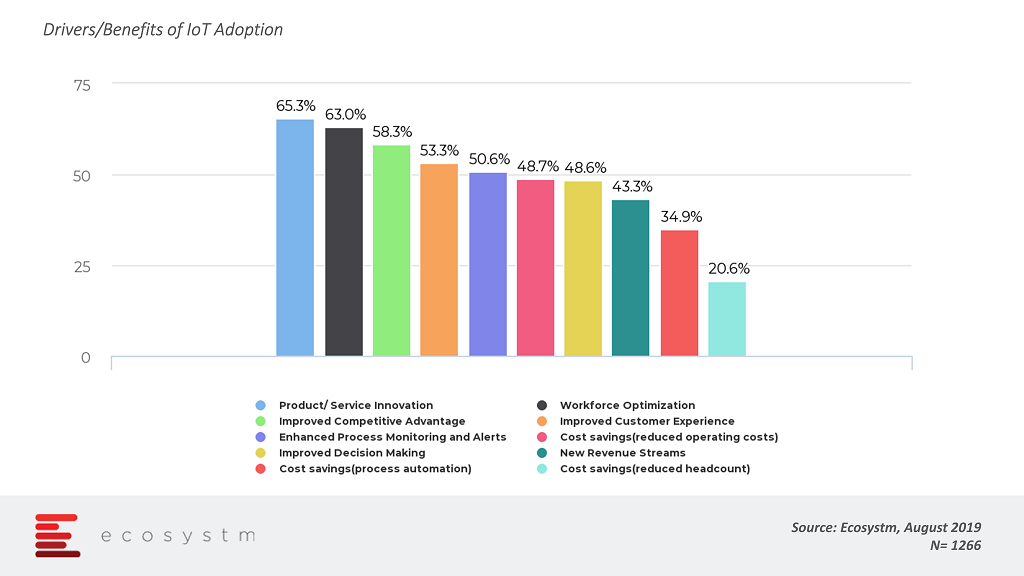
The key to IoT is connecting any physical ‘thing’ to the Internet, allowing remote control and monitoring functionalities over the network. The power of the technology comes from the fact that these devices can then be used to monitor and get data from virtually any other device or application. This opens immense avenues for the connectivity of various applications and expands the overall potential of the Internet dramatically.
The simplest way to appreciate how IoT can benefit organisations is to see its operations in some industries. The list below is not exhaustive and includes:
- Medical and Health: The key technology enabling eHealth is IoT. IoT has enabled remote diagnostics and patient monitoring even beyond the walls of the hospital. Remote monitoring has a deep impact on improving health outcomes and enables community-based healthcare and aging in place practices.
- Construction: IoT enables almost all home and office devices to be virtually connected allowing remote activation and control based on specific data gathered from the environment. This application is being utilised in ‘smart homes’ and commercial buildings, allowing the automation of security, lighting, HVAC and other systems. IoT applications have made their way into Building Information Management (BIM) systems even at the design and construction phases.
- Energy and Environment: In one of the early use case in energy efficiency and distribution, IoT is used to monitor the energy requirements of homes and industries with the help of ‘smart grids’. The technology is also helping meteorologists to predict storms, earthquakes and other natural disasters with the help of smart sensors to monitor environmental changes.
- Transportation: Autonomous Vehicles or driverless cars have become the popular face of IoT application. More significant than the vehicles or the technology itself, are the parameters that are involved in providing the right infrastructure for these vehicles. IoT is already bringing substantial improvement in the industry with connected transportation systems and controls in the applications for trains, smart cars, and airplanes
- Manufacturing: The Manufacturing industry is where the concept of process automation originated. Needless to say, the industry is seeing an uptake in IoT as automation reaches a whole new level. The adoption of IIoT (Industrial Internet of Things) is allowing manufacturers better visibility of the supply chain, more efficient inventory management, and proactive asset management through predictive maintenance. This impacts both the productivity of the plants and the quality of the products.
- Agriculture: IoT has numerous use cases in making Agriculture more productive and efficient, such as automated irrigation systems, crop monitoring, pest control, driverless tractors, and other smart farming solutions. Smart Farming practices will ensure a better outcome for environment management and promote trust in agricultural products as the entire ‘food to fork’ supply chain becomes traceable.
- Smart cities: ‘Smart city’ is an often-used term that can have different meaning depending on the maturity of the country. What is common however is the widespread deployment of IoT applications, devices, and sensors to handle various activities providing citizen services and infrastructure monitoring such as traffic management, street lighting, citizen security and monitoring, and more.
The early use cases of IoT have been in automation and asset management. As technology and connectivity evolve, the applications will be more widespread and impact every aspect of our lives.
Organisations are increasingly focusing on customer experience (CX), and it is overtaking pricing and product development as the key brand differentiator. The global Ecosystm CX study discovered that improving customer satisfaction is the key business priority across industries – even in industries that have not had a traditional focus on customers such as Manufacturing and Construction.
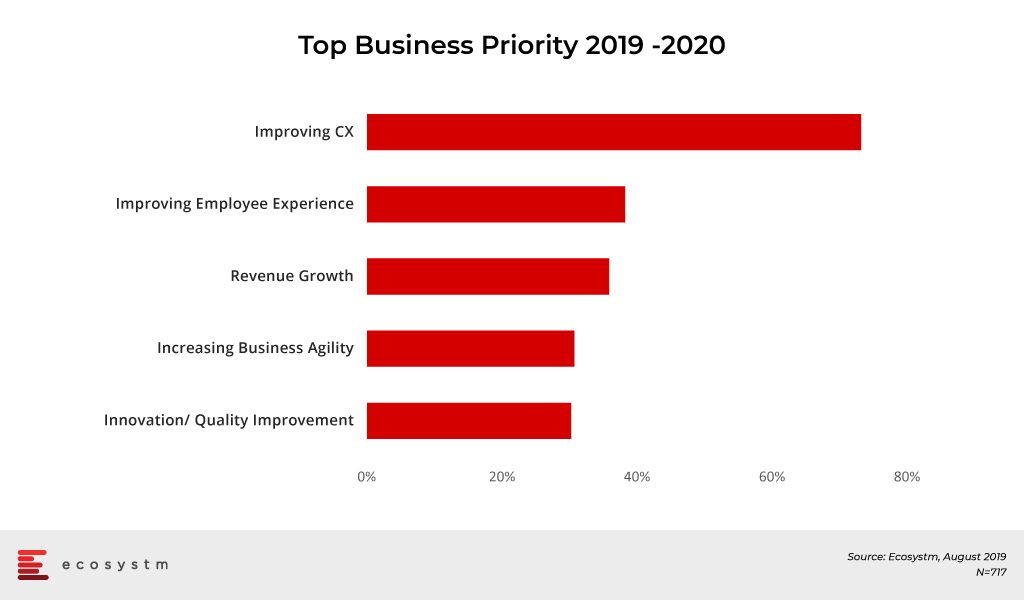
IoT is already impacting CX
We should keep in mind that IoT customers are not just those who enjoy the advantages of a Smart Home or the patients that share health and wellness data from wearables and medical devices with medical professionals. IoT customers are also the Maintenance Director of a Manufacturing plant floor, the Field Service technician using a predictive maintenance application, the Purchasing Director, the Marketing Director or the Product Director who use sensor data from connected products around the world in an intuitive and easy-to-use platform to improve usability or to sell more.
IoT can improve CX on multiple counts
Let’s see some examples:
- The right IoT sensor and actuator can boost customer satisfaction. For instance, by installing intelligent IoT sensors in the physical store environment, retailers can collect contextual data such as sound, temperature, or traffic patterns and will uncover how physical elements of a location correlate to customer satisfaction.
- IoT devices like wearables or smart home devices with good features improve the quality of life and have revolutionised CX.
- Effective IoT connectivity management is key to a successful IoT deployment. IoT connectivity enriches communication with customers too. The sensors and IoT devices that are inbuilt into products can feed data back regarding usage patterns and even detect problems. This data can be used to the manufacturer’s advantage allowing them to send across personalised communication to customers.
- IoT platforms with Artificial Intelligence (AI) components facilitate analysis of the ways customers are interacting with their devices over time, and helps identify frequently and rarely used features, allowing the building of better devices and applications fitted better to customer needs.
- IoT applications like condition-based monitoring allows the prevention of failures before they occur rather than waiting for problems to arise first. Connected devices can schedule predictive maintenance, detect issues before they debilitate functionality and diagnose problems accurately. When connected to a powerful AI-based workforce-management solution, companies can optimally schedule a technician by balancing skills, asset location, parts, technicians’ locations and traffic.
- IoT aids CX through faster Customer Service/Customer Support. Intelligent IoT devices itself could communicate an issue to a support team, even if the customer is unaware of one. Based on this information, a support team could then take several pre-emptive actions, which could include either notifying the customer or even rectifying the issue before the customer is affected. IoT sensors may be able to predict problems before they surface. Perhaps a piece of equipment exhibits certain symptoms before it breaks down. If the IoT device could send an alert to an engineer warning them about the potential problem, the equipment could be fixed before the problem leads to any downtime.
Designing an IoT Product Strategy centred around CX
Here are some points points to keep in mind when designing IoT products with a better user experience.
- The data that you havee gathered from the usage of your products can be used to develop new products. You can figure out what part of your products can be improved upon and then pass on this information to your product development team.
- Never introduce a User Experience (UX) based functionality that does not comply with the core values that the IoT product aims to provide.
- Since IoT-enabled devices come equipped with several sensors, they can easily capture loads of data regarding product motion, biometrics, air moisture, temperature, weather, etc. The product should be designed in such a way that the device makes optimum use of this data to learn deeply about the user and start taking smart and automated decisions on its own.
- Focus on making it easy for the customer to personalise the interface of smart products.
- Think beyond the usual interfaces that are based around screens. Combine with other technologies like AR, Voice Recognition, etc to obtain the desired output functions.
- Your IoT device design should make things simpler and not introduce more complexity into the equation. They should be designed in a way that it involves a minimal amount of training.
- Design with the intent of keeping machine-to-machine interaction at the maximum and autonomous behaviour at the minimum.
- Place the centre of control in the hands of the users. The interface design should make them feel like they run the show. One of the best ways to do this is by enabling remote user interfaces.
- Get information about the time gap between procuring a product and using it, and the date when the product is up for replacement.
- Combine IoT and AI for a better CX.
IoT is no longer in its infancy. The technology is here, available and ready to help organisations connect better to their audiences. There are already millions of users enjoying the benefits of and working with IoT devices. The possibilities of improving CX via IoT are indeed monumental. To keep up with market expectations, IoT vendors must be convinced that IoT will have tremendous positive impact on their relationships with their customers.
IoT vendors should be transparent and inform customers that they are using their usage data to optimise the design of products and services and to significantly improve customer satisfaction.
What are your views? Let me know in the comments.
In an industrial backdrop, drones are forming a core part of automation. Drones are Unmanned Aerial Vehicles (UAV) that can be controlled remotely or can fly autonomously with defined coordinates working with onboard GPS and sensors. The basic functionality of drones is to collect specific information about an environment and relay it back to the controller.
Industry 4.0 sees several use cases for drones. UAVs are the next-generation technology for industrial sensors and IoT. Industrial drones operate under difficult conditions – in regions where humans cannot physically inspect the environment such as in hazardous or hard to reach areas. While they are primarily sensors, they are also being programmed to act of the information gathered.
So what are the industrial applications of drones?
Some industries are more enthusiastic about the application of drones. In the global Ecosystm IoT Study, organisations that have implemented or plan to implement IoT in the next 12 months were asked about the adoption of drones for asset management.
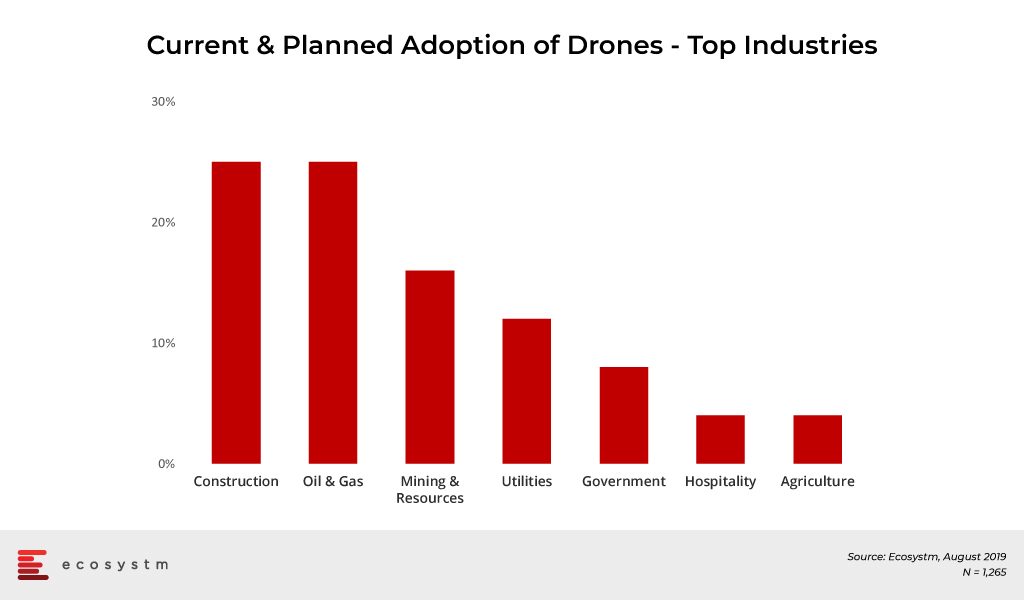
Construction
Industrial IoT is opening up opportunities for construction organisations. IoT devices have the potential to increase efficiency of construction sites and drones are one of the devices that can enhance safety and site operations. Instead of deploying heavy machinery and expensive tools, drones offer the capabilities to survey industrial sites to providing greater accuracy to building maps, QC processes, documenting project details – while reducing costs and project duration.
KIER, a construction and property group in UK is utilising drones to capture project progress, take 360 photographs and use it for photogrammetry (using photographs to model real-world objects and scenes). The benefits that the company reports include digital asset management and data insights, which in turn lead to cost reductions.
Drones will become an integral part of the Construction industry, to a large part because of safety and compliance requirements – and the industry needs to be prepared for it. UK’s Engineering Construction Industry Training Board (ECITB) has launched a training course and program for industrial drone operators to attain and develop the skill to safely fly drones and operate industrial equipment that has specific operational hazards and constraints.
Energy and Utilities
This is another industry group that can benefit in a similar way from drones. Drones can perform hazardous jobs otherwise performed by humans such as surveying transmission lines, inspecting plant boilers, monitoring the health of solar panels, assessing storm damages and even repair faster. The industry has been traditionally using helicopters but drones are a lower-cost alternative – both for procurement and maintenance.
It is easy to see why Laserpas, one of the largest Utility Asset Management Companies in the EU is using drones for their workflow automation initiatives. Laserpas surveys power grid infrastructure, including power lines, transmission towers, adjacent areas and so on, with the help of drones. The drones are gathering data for AI-driven data analysis to increase the efficacy of their high-precision monitoring solutions
Laserpas is by no means alone – AT&T is using drones to avoid service disruption through aerial monitoring of towers, replace faulty parts and create portable cell towers in mission-critical areas.
Government
Perhaps the earliest adopters of drones were a military defence in several countries. However, the use cases in Government are not restricted to that – it involves public safety and logistics in several Government agencies. They have become the means for agencies to gather data – both for situational awareness and scientific purposes – in a more efficient manner.
The ability of UAVs to cover large areas in a short time is helping emergency teams in search and rescue operations. The example from UK where a man involved in a crash was rescued from freezing temperatures by police drones, is a case in point. The emergency unit equipped a drone with a thermal camera that was able to locate the man in a six-foot deep ditch more than 500 feet from the crash site. There are examples of Public Health as well. In a municipality in Spain, mosquito control programs are using drones to conduct surveillance in likely breeding sites that are hard to reach. Once larval habitats are identified, drones are also programmed to spray pesticides to the area. Transport drones are also being used by Public Health agencies. Ghana’s government uses drones to supply blood and other critical medical supplies to remote areas. It has had a positive impact on the nation’s overall medical supply chain and the Ghana Civil Aviation Authority have plans to create an air corridor for the drones to prevent collisions with larger aircraft.
Perhaps the biggest use case for drones in Government will come from public safety measures. The Washington State Patrol has built up a fleet of 100 drones and using them for maintaining law and order in the state and for wide range of purposes including surveillance of armed and barricaded suspects and search and rescue operations. This will probably see a higher uptake than other solutions in Government.
Hospitality, Retail and Logistics
Though the adoption of drones in these industries is not yet as widespread as in others, there is tremendous potential in inventory and supply chain management. Walmart has conducted pilots on drones for warehouse management which has now been moved to implementation. Using drones reduces the need for heavy assets such as forklifts and conveyor systems.
UAVs are the best new way of tracking inventory using tracking mechanisms such as RFID and QR-codes UPS has set up a subsidiary that uses drones for delivery. Companies such as DHL, Amazon, and Google are developing and experimenting with drones to speed up delivery, especially for lightweight consumer goods. Drones not only help with inventory management but also ensures last-mile delivery.
The Hospitality industry has gone beyond logistics in their business application of drones. Examples are broad including creating marketing videos for properties, aerial site maps to help guests and staff members navigate sprawling grounds and surveillance. Drones make it possible to create a 3D virtual environment for security teams to monitor hotel perimeters, parking lots and outdoor venues effectively. This is more economical than hiring a full-time security crew for surveillance cameras and 24/7 monitoring. The Seadust Cancun Family Resort has a lifeguard drone that helps real lifeguards by supplying safety equipment and emergency floatation devices.
Agriculture
Drones are a major component of smart farming techniques and operations where farmers can benefit from real-time information about large tracts of land.
“An ‘eye in the sky’ by way of a drone, can save days for farmers and help them in checking stock, crops, and fences, battling weeds, and even mustering cattle. Simultaneously, they can provide data to help farmers make more informed decisions around applying fertilizer, disease detection, and about managing health and safety on farms,” says Jannat Maqbool, Principal Advisor Ecosystm. (Read Jannat’s Report on IoT in Agriculture: Drivers and Challenges)
Yamaha is working with farming communities in several countries to use UAVs to spray weed killers. Drones are utilised to spray the crops applying small quantities of pesticide or fertilizer to crops, orchards and forested areas. GPS coordinates create flight paths to aim for maximum coverage. This is leading to process automation in Agriculture – an essential component of smart farming.
Drone have started to prove their worth in various industries across applications and organisations across the globe are working to integrate drones into their operations. As laws mandating them to become clearer, more industries will look to leverage drones for automation.
Which are the other industries that will see a steady uptake of drones in the near future? Tell us your thoughts.
For years, I have been writing about the promise and perils of the Internet of Things (IoT). In many of my articles, I described how the IoT could help transform society and kickstart the next industrial revolution. However, still many people and enterprises are not deploying IoT. We still cannot define in a unique and clear way what IoT is, much less explain how it will change our lives, without using the example of the smart refrigerator!
Why are we still at a loss with IoT? Let´s explore.
Lost in IoT Connectivity
With so many IoT connectivity options in the market, choosing the right one for your project can be complicated. It is a scary thought that billions of devices could be connected in a few years to decentralised IoT networks, with no interconnectivity between them, unless we use millions of edge nodes that transfer messages between devices connected in multiple networks. If it is already difficult to justify the ROI of a use case using a single type of connectivity – it is almost impossible to justify that these devices will need to communicate with other devices on different IoT subnets.
It seems that it is easy to get lost in so much connectivity technology. Isn’t that true?
Lost among hundreds of IoT Platforms
At least we can already intuit some of the platforms that will survive among the 700+ that some analysts have identified. I have only been able to analyse about 100 of them in some depth. Surely my methodology of Superheroes and Supervillains will advance the end of most of them.
It is no longer just one IoT Platform. Although they want to make it easy for us, companies like AWS, Microsoft or Google add concepts such as Serverless, Data Lakes, AI, Edge Computing, DLT and all the artillery of Cloud services to the core features of the IoT platform. It is easy to get lost in the architecture.
Data from the global Ecosystm IoT Study shows this confusion in selecting the right platform for future adopters of IoT. Same organisations indicate that they will use or at least evaluate several platforms.
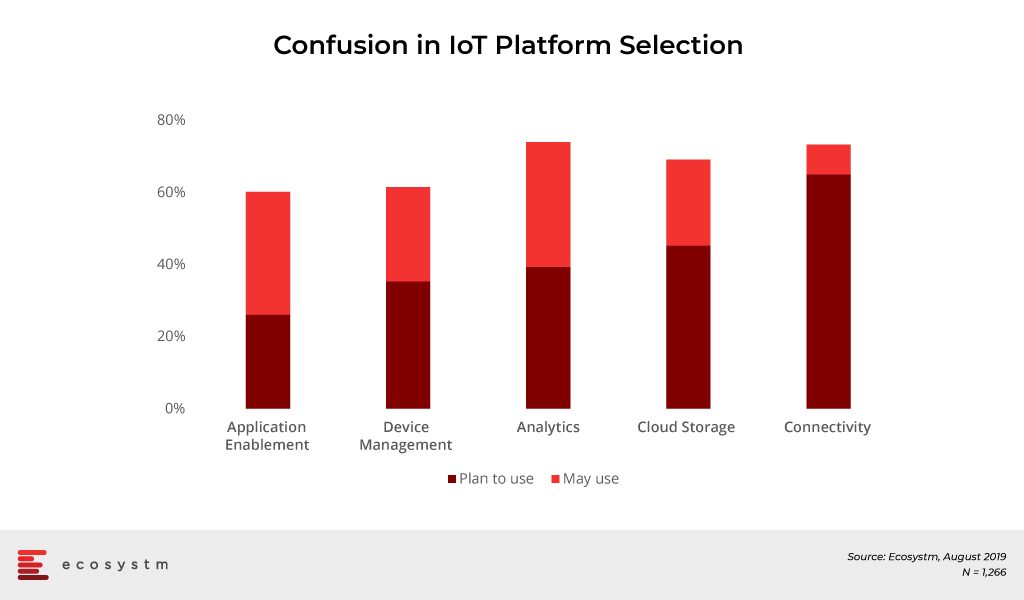
Initiatives such as Verizon’s focus on connectivity and systems integrators abandoning their in-house developments to embrace leading vendors’ offerings, will reduce some of the confusion around IoT platforms.
Lost between the Edge and the Cloud
In “Do not let the fog hide the clouds in the Internet of Things”, I had warned about the degree of complexity that Fog /Edge Computing will add to the already complex IoT solutions. Now nothing seems to be of great value unless Edge Computing is included.
The Babel tower of alliance and consortia is consolidating, but people still get lost in the acronyms. News such as the merging of the Industrial Internet Consortium (IIC) and the OpenFog Consortium (OpenFog) to combine the two largest and most influential international consortia in Industrial IoT, fog and edge computing, has been hailed by many. The Open Group Open Process Automation Forum (OPAF) is defining the next generation edge computing standards for industrial operators.
And again, the question arises, do all organisations need Edge to start an Industrial IoT project?
Lost in Proofs of Concept
Businesses are estimated to be spending USD 426 Billion worldwide on IoT hardware and software in 2019 alone. Yet, three out of every four IoT implementations are reported to be failing.
Microsoft launched a new research report – IoT Signals – intended to quantify enterprise IoT adoption around the world. The survey of over 3,000 IT team leaders and executives provides a detailed look at the burgeoning multi-billion-dollar segment’s greatest challenges and benefits, as well as related trends. Perhaps it is not surprising that 30% of respondents say their IoT projects failed in the proof-of-concept (PoC) stage, often because the implementation became too expensive or the bottom-line benefits were unclear.
There are technical reasons – for example the use of Rasberry Pi or Arduino boards in the PoC and then later realising that more expensive hardware is needed for the actual project. There are economic reasons when organisations try to escalate their PoC to real implementations and then the ROI does not look as good as in the pilot.
There are organisational reasons when leaders are failing to go all in. If you cannot get the CEO on board, then the probability that your IoT project will end at the PoC stage is almost 100%.
If you are lost in the PoC, these tips can help you implementing IIOT.
- Solve a problem worth solving
- Keep it quick and simple
- Manage the human factor
Lost in selecting the right IoT Ecosystem
Today no significant ecosystem or network of collaborators has emerged in the IoT arena in spite of early and very interesting efforts being made by several players. Since I wrote “The value of partnership in Industrial Internet of Things”, I have heard, read and repeated hundreds of times how important it is to belong to an IoT ecosystem and how difficult it is to choose the one that suits you best.
Those who have read my articles know that there is no company in the world, no matter how great it is, that can do everything in IoT. Creating an IoT ecosystem either horizontal (technology) or vertical (industry) requires a lot of talent managers able to maintain win-win transactions over time. And according to the results, it appears to me that it is becoming very complicated.
Remember, you are not the only at a loss with IoT
When it comes to achieving an ROI from IoT, businesses really need to rethink how they are deploying it and ensure that they can manage their sensors remotely, secure their assets, use the sensors and devices data to make better real-time decisions and monetise it. However, for that to happen and to prevent the IoT projects from failing, businesses need independent and expert advice at several levels to find the right people to lead the project and the right technology and partners to make implementations successful.
The global insurance industry today faces several challenges – starting from the shift in the demographic patterns and the disease burden, to managing an ever-growing agent ecosystem, to responding to customer expectations. The advancement in technologies and their adoption is creating opportunities for insurance companies to modernise and reinvent themselves through new product and services offerings and by evolving their business models.
Drivers of Transformation in the Insurance Industry
- Global Competition. Over the last few years, leading insurance providers have been looking for a share of the global market and are no longer content with their traditional domestic markets. They especially want to get into markets where there are fewer players and/or larger population. The Indian insurance industry, for example, has seen a number of new private entrants over the last decade, attracted by the large population base and by a high percentage of young population. Many of the leading global insurance providers have partnered with Indian counterparts for a presence in the market. The story is similar in several emerging economies. While the presence of insurance providers is good for the future sustainability of a country, the market is extremely competitive. Investing in technology can be the key differentiator in capturing a larger share of the pie.
- Customer Expectations. Today’s customers are tech-savvy and expect a certain level of service and at their fingertips too. Moreover, easy access to the internet equips them to do basic research to evaluate their best options. The Fintech revolution also impacts the customer base, as they expect services such as instant approval and prefer to purchase items only when they require them. This ‘on-demand’ market has fueled the microinsurance industry and opened the gates for smaller providers.
- Regulatory Requirements. In the aftermath of the financial crisis of the previous decade and with new entrants in several countries, regulatory authorities are working on an overdrive to bring better accountability to the insurance market. Moreover, in most countries the regulations have incorporated market conduct guidelines aimed at consumer protection. Reporting, service level and fraud prevention requirements will see an increased uptake of technologies that can assist in fulfilling compliance requirements.
Key InsureTech Technologies
- IoT. The auto insurance companies were the first to leverage IoT and telematics to enhance navigation, safety and communication features that could help customise the premiums payable. The home insurance sector has already leveraged it using sensors and connectivity to assess and reduce risks to the properties they insure – large providers such as Allianz, Aviva and AXA have been working on their IoT ecosystem. This has immense potential for ‘usage-based’, personalised product and premium offerings in the health and life insurance industries (provided they work within the purview of compliance requirements). Ultimately sensors are not the most important technology in an IoT solution – the analytics solutions that can derive intelligence from the sensor data are. IoT+AI will give that much-needed edge to insurance companies.
- AI – Machine Learning. AI and machine learning make it possible for insurance companies to mine both structured and unstructured data. The use cases range from underwriting, claims management and personalised offerings through behavioural data and sentiment analysis. There are examples of early adopters in the auto industry – but again there are obvious and wider use cases, that can benefit risk modelling, pricing, customer acquisition, and agent and channel efficiency.
- AI – Virtual assistants/Chatbots. This falls right in with managing customer experiences. As customers expect more self-service (yes, the future will see less agents!) several insurance providers are using chatbots at several customer touchpoints, covering departments such as Sales and Claims. This will increasingly be the norm as smart phone (and app) penetration increases and the target base becomes younger. There are online-only insurance providers where clients interact with chatbots services and they are able to cater to a larger, untapped, mass market. There are more advanced adoption examples such as USAA’s use of intelligent personal assistant equipped with an NLP engine that have been trained with a deeper knowledge of policies. Virtual insurance agents will become more of a norm in the near future.
Which brings us to the important question on how insurance companies are planning to leverage InsureTech. Multiple stakeholders could benefit from InsureTech adoption. The Claims department appears to be a key stakeholder, focused both on fraud prevention and automation when it comes to transaction and processing. Sales and Customer Service appear to be next in line, where personalisation of product offerings would equip the teams better for a competitive market.
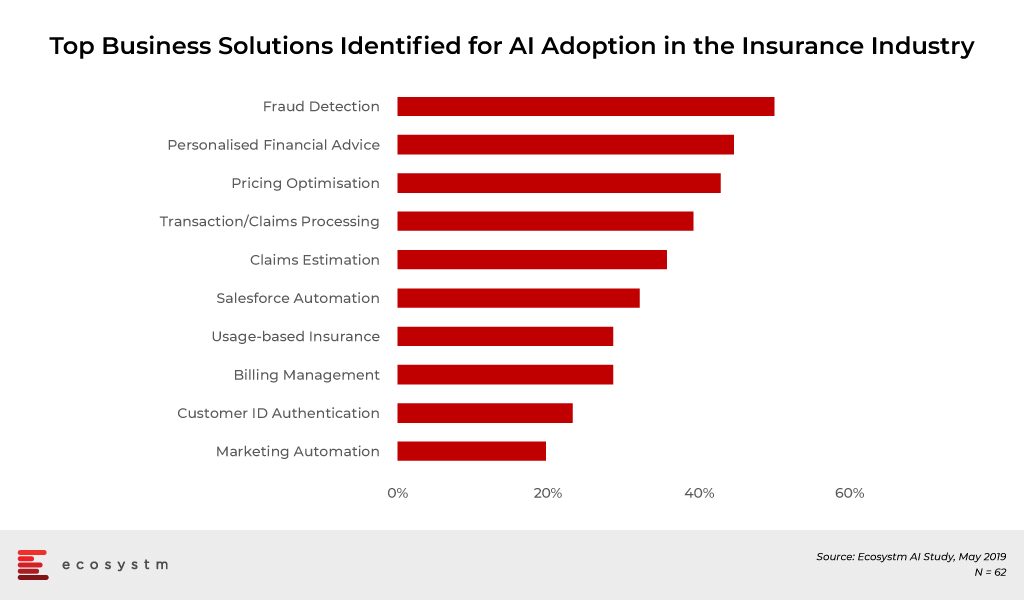
Challenges of AI Adoption in Insurance
It is obvious that the insurance companies are still at a nascent stage of adoption of AI and InsureTech. While cybersecurity is a recurrent concern (as it should be), it is a common concern across any technology area. The biggest challenge that the insurance industry faces in adoption of AI and other data-driven technologies is the actual data management – from access to integration. The industry may be data-intensive, but the data exists in silos. In the end an InsureTech implementation should benefit multiple departments – Underwriting, Claims, Sales and so on. 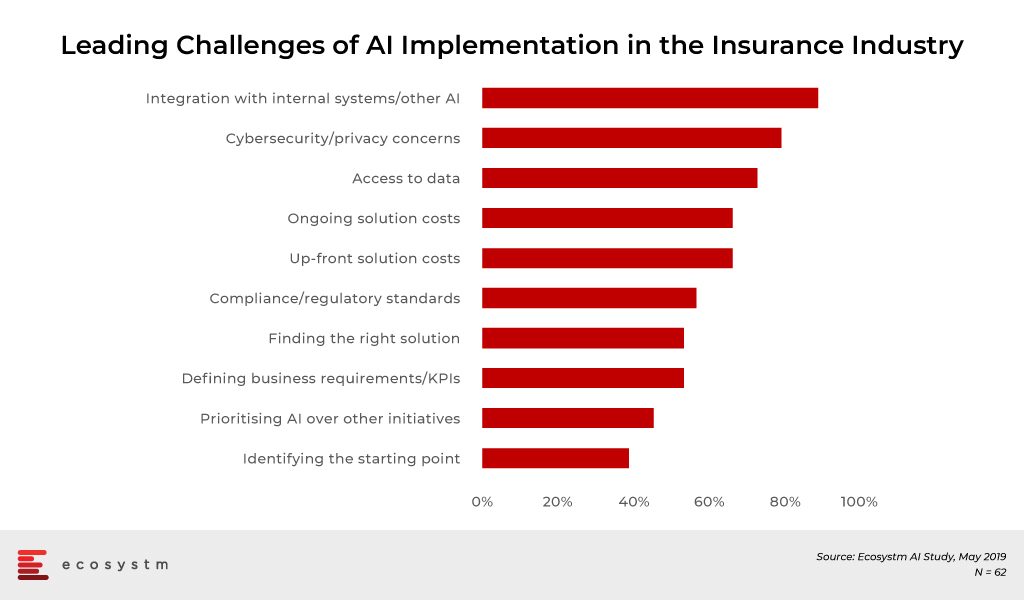
Several insurance companies will look to consulting firms and systems integrators to create a roadmap to their transformation journey and enable the data integration – especially as technologies evolve and when internal IT lack the right skills to manage these projects.
The technology that will be the key component of InsureTech and transform the insurance industry is AI. In spite of the challenges of adoption, the industry will be forced to transform to survive in the highly competitive market. Companies in emerging economies will especially benefit from investing in AI – in fact, India and especially China will see a surge in InsureTech investments.
The nature of the workplace has changed over the years and so has the number of devices being used by today’s employees. More and more organisations are adopting a ‘Mobile First’ strategy – designing an online experience for Mobile users before designing it for the desktop/ Web. This is a paradigm shift from the past, where enterprises modified or adapted their websites, business processes and digital means of communications, to fit Mobile users.
Mobile First Drives the Adoption of UEM
Mobile First application designs take into consideration that Mobile users are constantly on the move. Information needs to be presented to them on smaller screens/displays with multi-media interfaces (voice/video), and multiple network connectivity options (Wi-Fi, cellular, and so on).
The global Ecosystm Mobility Study reveals that 73% of organisations have a Mobile First Strategy in place and are at various stages of implementation. About another 25% of organisations feel the need for a Mobile First vision and are formulating a strategy.
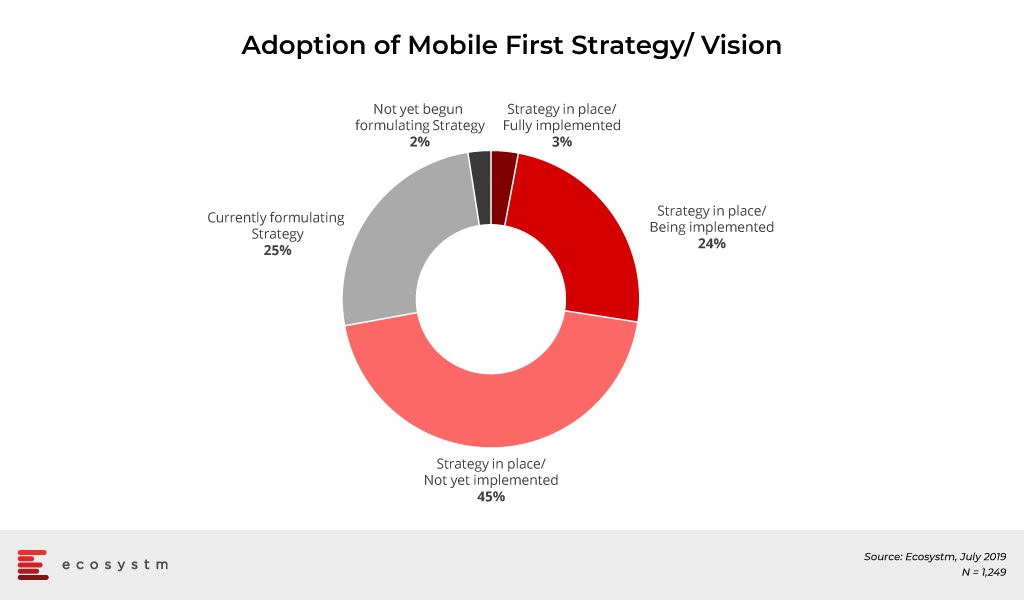
With Mobile First strategies, organisations are adding a wide range of devices and operating systems (OSs), regular innovative mobile-centric workload rollouts, new mobile apps across multiple functions, and IoT initiatives. As a result, organisations now have the need to support multiple devices and endpoints (including IoT sensors and wearables) multiple OSs, applications, and mobility policies such as BYOD. Organisations struggle to manage these devices, their data, apps and software updates across heterogeneous OSs and platforms. “The way companies are growing and fuelling their teams with devices now, shows the trend that these organisations will follow in the next few years, which will require a higher level of sophistication from the Unified Endpoint Management (UEM) solutions in the market,” says Amit Sharma, Principal Advisor, Ecosystm.
How does UEM Help?
An UEM solution can configure, monitor and manage multiple OSs, devices including IoT sensors, and gateways, and
- Unify application and configuration
- Manage profiles
- Monitor compliance
- Enforce Data Protection policies
- Provide a single view of multiple users
- Collate data for Analytics
It can ease the burden of management activity of internal IT teams and allow organisations to create a more streamlined lifecycle that secures mission-critical technology. It can also offer proactive threat monitoring, access control and identity, and patch management.
A good UEM solution provides IT managers with a transparent and traceable overview of all endpoints within the network as well as the power to manage all connected devices from a single platform. It maps out the network setup and structure by carrying out a complete inventory of all network devices, configurations, installed software, and the drivers for endpoint subsystems.
There are simply too many endpoints within Industrial IoT (IIoT) for IT managers to efficiently monitor manually. Mistakes will be made, and opportunities to stop breaches before they escalate will be missed. “An UEM solution not only shows the software and licensing situation but scans the IT environment for any irregularities or vulnerabilities and allows risk assessment and patch installation where it is necessary”, says Sharma. “Providing IT administrators with automated vulnerability management will enable them to filter and set search criteria by device, security vulnerability and threat level for the higher and most timely degree of protection.”
Industry Adoption of UEM
Customer-focused industries, with mobile workforces, are adopting UEM faster than other industries. The global Ecosystm Mobility study found the top industries that have implemented UEM or plan to in the near future. Most of the top industries cater to a high percentage of mobile workers. Their need to adopt UEM can come from different angles. According to the study, the Telecommunications industry leads in Mobile Content Management (MCM) adoption, and mobile apps for logistics and operations appear to be the key driver for the industry uptake of Mobile Applications Management (MAM).
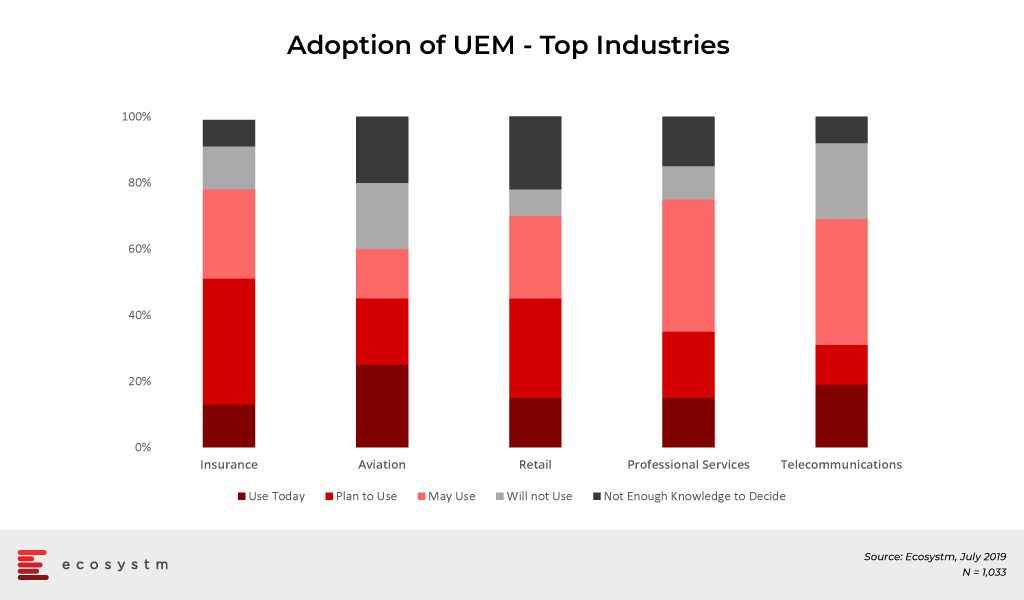
Other industries to look out for in the future are Banking and Healthcare, as they lead the pack when it comes to MDM adoption. Banks are incorporating technologies, such as mobile banking, and enabling payments via smartphones to provide enhanced services to customers. We have also seen the advent of Smart Point of Sale devices which are managed remotely on cloud infrastructure and these millions of devices will also be required to be managed by the banks that issued the devices.
The healthcare industry is another vertical where we can expect a higher uptake of UEM in the coming years. Clinicians and care providers are increasingly mobile, switching from device to device, depending on the task and location. Accessing mHealth applications and patient data from any device securely enables caregivers to focus on patients and outcomes. It also allows them to complete critical tasks from any device whether they are on call or off work. UEM makes HIPAA, SOC 2 and other healthcare regulation compliance easy for the providers.
Challenges of UEM Implementation
User experience must be at the centre of any mobility initiative. If the device, app management, or content is not something users want or are able to use, then it simply will not be adopted. The success of an UEM solution lies in the ability of users to quickly authenticate and gain seamless access to corporate apps and data from their devices. Users should also have access to self-service tools that help them manage basic device features and troubleshoot problems quickly.
“We can expect most Enterprise Mobility Management (EMM) and MDM suites to migrate to complete UEM suites that manage personal computers, mobile devices and Internet of Things (IoT) and Enterprise of Things (EoT) deployments,” forecasts Sharma. “Organisations should look for a purpose-built UEM solution which is platform-neutral and which cultivates a thriving ecosystem of complimentary mobile solution providers.”
However, there are several challenges that organisations face when they are developing and deploying an UEM solution. Sharma lists the top UEM implementation challenges that can be broadly classified into the following five categories.
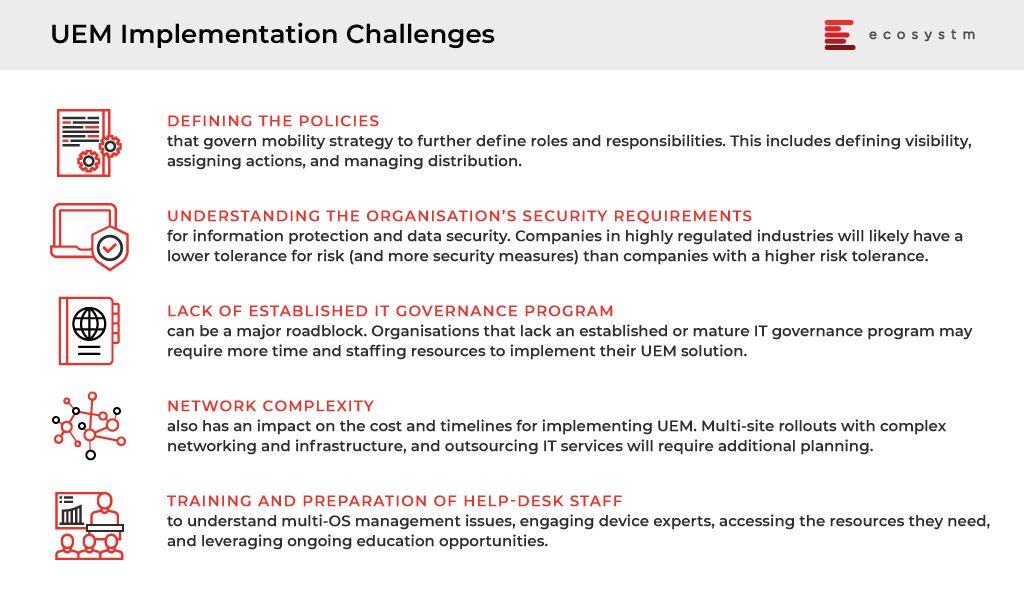
“As AI finds its way into mobile devices and virtual personal assistants proliferate in offices and boardrooms, IT admins will have to manage more – and more sophisticated – endpoints. AI will continue its push into mobile hardware and enterprise communication devices, challenging IT shops’ EMM capabilities while at the same time offering potential security benefits.” Sharma adds. “Also, in 2019, voice-activated assistants such as Amazon Alexa and Cisco Spark Assistant will find their way into more corporate offices and conference rooms – becoming yet one more enterprise device encouraging the adoption of an UEM strategy.”
Have you adopted an UEM strategy in your organisation yet? Share your experience with us in the comments section.
The construction industry employs about 7% of the world’s working-age population and although many people think that robots will take away their work, construction workers should not be worried at this time.
In 2017, McKinsey Global Institute published a surprising report: labour productivity in construction has decreased by 50% since 1970. In addition, McKinsey believes that productivity in construction has registered zero increases in recent years. While other industries have been transformed, construction has stalled. The effect is that, when adjusting to inflation, a building today costs twice as much as 40 years ago.
And although the construction industry is a growing market, there are still some problems that need to be handled to increase profitability and productivity. The main problems facing the construction industry in 2019 are:
- Shortage of skilled labour
- Rising cost of steel, aluminium, wood and other materials.
- Decline in growth
- Low performance projects
- Sustainability
- Security
- Inconsistent use of technology
The construction sector has been positive for the past four years, mainly due to the recovery of residential construction. However, the growth can still be erratic. For example in Europe, after the precedence of the previous decade, a scenario is being predicted where 2020 still shows positive growth (3.5%) but 2021 may not (-3%).
Adoption of Technology in Construction
The construction industry is notoriously slow in adopting technologies such as IoT that could boost productivity and, ultimately, profitability.
And although it is believed that construction companies that adopt this technology would also be able to attract new labour force to work for them over others and, in general, have a significant advantage over competitors, the reality is that it is not happening. The general vision insists on a reality: construction and engineering companies see the need for change, but in one way or another they resist.
One of the biggest opportunities of the construction sector is its enormous capacity to reinvent itself. Building Information Modelling (BIM), 3D printing and Virtual Reality (VR) can help architects and builders in creating a construction model. These technologies, along with drones and IoT can be of enormous help to construction workers, increasing their efficiency and ensuring their safety. Materials science is also developing newer material that can impact the industry. The integration of technological trends such as IoT, will facilitate many of the tasks of the sector, optimising resources, improving compliance with deadlines and quality in projects and works.
The Opportunity of IoT in Construction
The appetite of investors for start-ups in the construction sector is growing, although not many are in the IoT box. There are still few examples of companies in the sector that are adopting IoT. And although I have no doubt that IoT will positively impact this industry none of the productivity, maintenance, security and safety drivers seem to be convincing them at the moment.
In the global Ecosystm IoT Study, participants from the construction industry were asked about the key business solutions targeted for IoT uptake. While the industry is aware of the IoT solutions and the role they can have in asset and people management, the actual uptake of these solutions is far lower. Around a tenth of Construction companies have some sort of an IoT-enabled asset control and management solutions.
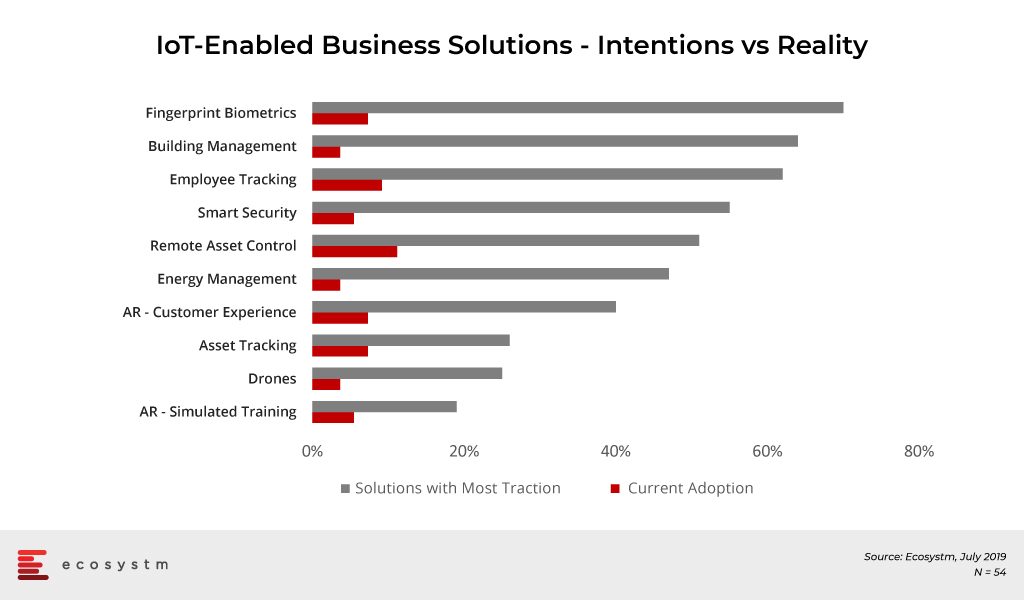
There are ample examples of innovation with IoT in Construction.
- Machine control
- Construction site monitoring (Examples include)
- Anchor load monitoring from installation
- Control of the deformation of the ground during the construction of a tunnel
- Monitoring changes in pore water pressure during soil consolidation
- Monitoring of the settlement process during the soil recovery works
- Fleet management
- Wearables with AR capabilities and safety measures
Some practical examples of IoT in Construction have been covered in the article and include
- Remote operation
- Replenishment of supplies
- Equipment construction and monitoring tools.
- Maintenance and repair of equipment.
- Remote use monitoring
- Energy and fuel savings
Key Takeaways
IoT and other emerging technologies can improve productivity, reduce costs and security in the construction industry. Construction companies, real estate and engineering firms should continue their investments in IoT.
They should not fall back into the same mistakes of the past and should not fear the loss of jobs due to the new technologies like IoT or Artificial Intelligence (AI). The adoption of IoT is unlikely to replace the human element in Construction. Instead, it will modify business models in the industry, reduce costly mistakes, prevent injuries in the workplace and make construction operations more efficient.
Smart Construction is key to building Smart Cities and is an element in Smart Building, Smart Transportation and even Smart Healthcare. The limits of using IoT in Construction is our imagination.
Thanks for your Likes and Shares.


